At Sea
Sagres Anchorage to Puerto Sherry 6-7 August
06/08/07 17:42
This was going to be a long leg. The longest since Gijon to La Coruña (140) miles. Daylight revealed our dramatic surroundings in Enseada de Sagres.
Our anchorage with the cliffs extending round to Ponte de Sagres.
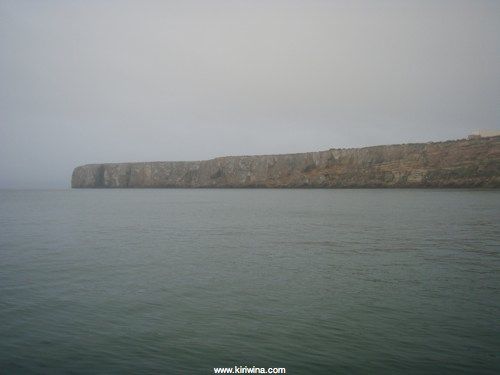
A beach off the starboard bow.
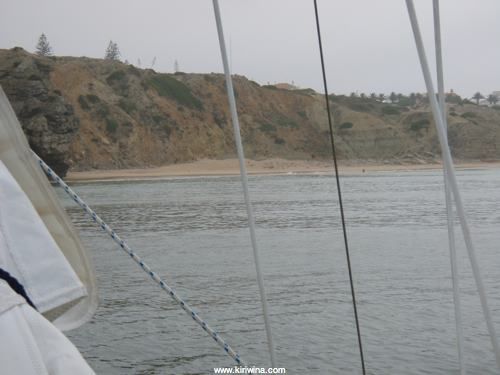
A white fort on the cliffs above.
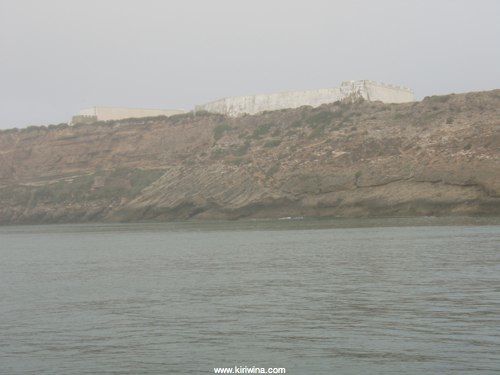
The pilot books refer to the climate becoming more "Mediterranean" once one has rounded Cabo Sao Vicente. When I awoke the weather was overcast with light drizzle and almost no wind. Very "Mediterranean".
We weighed anchor at 08:06 and set course for Cadiz. About an hour later, once clear of the Enseada de Sagres and a bit out to sea, the wind increased to NNW F4. We were now able to proceed under sail with a full yankee and one reef in the main.
Rock formations seen on exiting the Enseada de Sagres and looking along the Algarve coast towards Lagos.
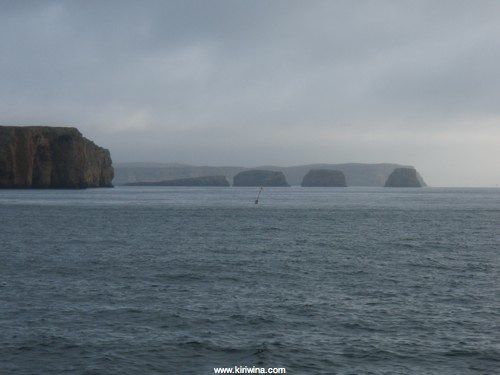
The wind remained at around NW 4 throughout the day with slight to moderate seas. The sun came out later in the morning.
We made good progress which continued when the wind backed to SSW F5 at 16:00.
By 21:00 the wind had eased and at 21:30 I put the engine on with the wind at around WSW F2-3.
Sunset in the Golfo de Cadiz.
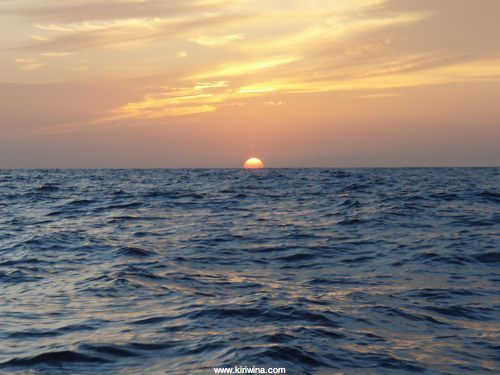
Tuesday 7th August 2007
At 01:30, with the clocks having been advanced 1 hour to Spanish time at midnight, the wind veered to NW F3-4 and the engine was turned off. We proceeded under full main and yankee throughout the night making good progress. This was much more enjoyable than motoring.
We were now well off the coast with no sign of any pot markers and only the odd distant fishing boat or cargo ship for company. I took the chance to take the odd catnap with the alarm set to 15 minutes.
At 06:45, with the wind having eased to WNW F2, I put the engine on. The wind continued to die away and when I pushed the engine a little harder there seemed to be more vibration than usual. I wonder if this is because of the fouled waterline.
As we passed the Bahia Cadiz approach buoy at 11:50 the engine was turned off and we proceed under sail. Canal Principal buoy #2 was passed at 12:05. Shortly after passing buoy #6 at 12:30 the sails were taken in and warps and fenders prepared for mooring.
At 13:00 we were all fast alongside the waiting pontoon at Puerto Sherry marina. Once in reception a rude shock awaited. At €28+ per night this would be the most expensive marina we had stayed in on the European mainland. Reception was very efficient and we were allocated berth 39 on pontoon B1 well inside the marina. They warned that standard shore power connections required conversion using a plug requiring a €75 deposit.
Before proceeding to the berth I thought it prudent to check the yacht club berths in nearby El Puerto de Santa Maria. These were not in good shape and looked to be a hazard when SW winds or passing traffic whipped up a chop in the river.
There was quite a chop running when I arrived at 14:10 and moored alongside a vacant outer pontoon, scuffing the hull in the process. On checking with the club office it was all academic anyway. Visitor berths were only available for one night.
Back on board I cleared the berth at 14:30 and proceeded back to Puerto Sherry. On the way I was called by friends in the town checking my whereabouts. I had given an ETA of lunchtime on the 7th.
At 15:00 we were all fast at our allocated berth in Puerto Sherry. The berth was just fine and well sheltered. The marina looked odd and had a neglected feel about it. That said, it was virtually full with mostly Spanish boats and a small number of visiting foreign yachts.
Passage Run: 138.9 miles Passage Time: 28hrs 54 min.
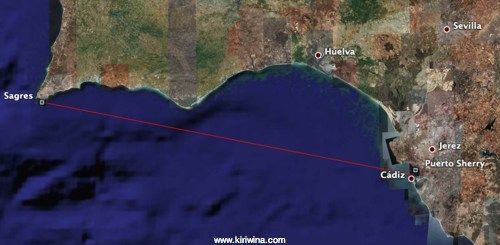
Our anchorage with the cliffs extending round to Ponte de Sagres.

A beach off the starboard bow.

A white fort on the cliffs above.

The pilot books refer to the climate becoming more "Mediterranean" once one has rounded Cabo Sao Vicente. When I awoke the weather was overcast with light drizzle and almost no wind. Very "Mediterranean".
We weighed anchor at 08:06 and set course for Cadiz. About an hour later, once clear of the Enseada de Sagres and a bit out to sea, the wind increased to NNW F4. We were now able to proceed under sail with a full yankee and one reef in the main.
Rock formations seen on exiting the Enseada de Sagres and looking along the Algarve coast towards Lagos.

The wind remained at around NW 4 throughout the day with slight to moderate seas. The sun came out later in the morning.
We made good progress which continued when the wind backed to SSW F5 at 16:00.
By 21:00 the wind had eased and at 21:30 I put the engine on with the wind at around WSW F2-3.
Sunset in the Golfo de Cadiz.

Tuesday 7th August 2007
At 01:30, with the clocks having been advanced 1 hour to Spanish time at midnight, the wind veered to NW F3-4 and the engine was turned off. We proceeded under full main and yankee throughout the night making good progress. This was much more enjoyable than motoring.
We were now well off the coast with no sign of any pot markers and only the odd distant fishing boat or cargo ship for company. I took the chance to take the odd catnap with the alarm set to 15 minutes.
At 06:45, with the wind having eased to WNW F2, I put the engine on. The wind continued to die away and when I pushed the engine a little harder there seemed to be more vibration than usual. I wonder if this is because of the fouled waterline.
As we passed the Bahia Cadiz approach buoy at 11:50 the engine was turned off and we proceed under sail. Canal Principal buoy #2 was passed at 12:05. Shortly after passing buoy #6 at 12:30 the sails were taken in and warps and fenders prepared for mooring.
At 13:00 we were all fast alongside the waiting pontoon at Puerto Sherry marina. Once in reception a rude shock awaited. At €28+ per night this would be the most expensive marina we had stayed in on the European mainland. Reception was very efficient and we were allocated berth 39 on pontoon B1 well inside the marina. They warned that standard shore power connections required conversion using a plug requiring a €75 deposit.
Before proceeding to the berth I thought it prudent to check the yacht club berths in nearby El Puerto de Santa Maria. These were not in good shape and looked to be a hazard when SW winds or passing traffic whipped up a chop in the river.
There was quite a chop running when I arrived at 14:10 and moored alongside a vacant outer pontoon, scuffing the hull in the process. On checking with the club office it was all academic anyway. Visitor berths were only available for one night.
Back on board I cleared the berth at 14:30 and proceeded back to Puerto Sherry. On the way I was called by friends in the town checking my whereabouts. I had given an ETA of lunchtime on the 7th.
At 15:00 we were all fast at our allocated berth in Puerto Sherry. The berth was just fine and well sheltered. The marina looked odd and had a neglected feel about it. That said, it was virtually full with mostly Spanish boats and a small number of visiting foreign yachts.
Passage Run: 138.9 miles Passage Time: 28hrs 54 min.

